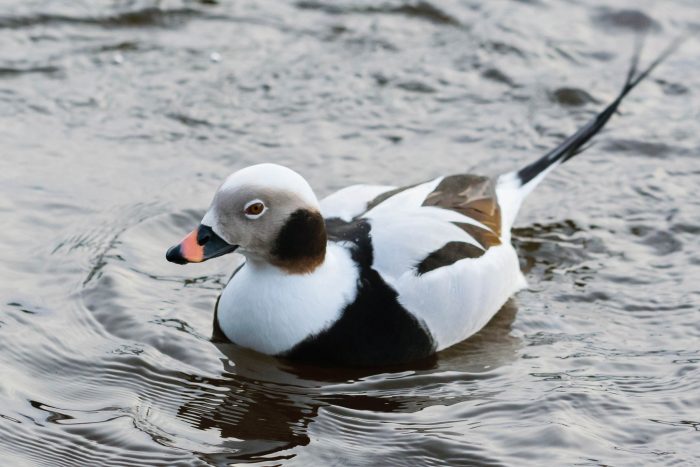Long-Tailed Duck
Clangula hyemalis
Once known as the oldsquaw, the long-tailed duck is a medium-sized diving duck with a short bill and heavy body, whose shape and structure are well-suited to diving deep into the water for food. Males possess two long and slender tail feathers, which give the species its common name.
This section shows one large critter image at a time. Use the thumbnails that follow to select a specific image to display here.

This gallery contains a grid of small thumbnails. Selecting a thumbnail will change the main image in the preceding section.
Appearance
The long-tailed duck has a short, chisel-shaped bill that curves at the tip and is used to snatch up prey from the seafloor. Males and females have different patterns and coloring, and shift between three different plumages as the seasons change. Unlike most ducks, long-tailed ducks do not always have a distinct pattern--both sexes' coloration is a mixture of white, black, brown and gray (although black wings are present in both sexes throughout all plumages). Males, or drakes possess two long and slender tail feathers and often have a pink band near the tip of their black bill. Females have dark wings, white sides and white neck and lack the long central tail feathers.
Feeding
Deep divers, long-tailed ducks have been reported to forage for food at depths of up to 200 feet, using their wings (more so than their feet) to swim underwater. In the Chesapeake Bay, birds normally dive to about 25 feet in order to reach food. The birds feed on aquatic invertebrates, including insects and crustaceans and also consume small fish, fish eggs and plant matter, including algae, grasses, seeds and fruits.
Predators
Long-tailed ducks are most vulnerable to predation on land. Avian predators include mew gulls, glaucous gulls and jaegers. Near breeding grounds, arctic and red foxes can also pose a threat.
Flight
The flight of the long-tailed duck is low with stiff, shallow wing-beats, often tilting from side to side.
Voice
The long-tailed duck is a vocal species with an extensive variation of calls and sounds integral in interspecies interactions like mating or raising young. Individual calls have been described as nasal growling, clucking, squawking and yodeling and can be heard across long distances. The male's call is a loud "ow-owoooleee." The call is a soft "gut-gut" when feeding, and a bark when alarmed.
Reproduction and life cycle
Breeding takes place in spring. Males exhibit elaborate courtship behavior, including dips, turns and a series of four or five deep-noted calls. The ducks may breed in single pairs or in loose groups. Pairs can re-form for several years or individuals may select new mates each mating season. Nests are constructed on dry land and hidden among rocks or other plant growth, often near the water's edge and close to the nests of other long-tailed ducks. The nests are bowl-shaped and built of willow or birch leaves or grasses and lined with female's down feathers.
Females lay between six and eight pale gray to olive eggs. Incubation begins once all eggs are laid and lasts 24 to 30 days. Females raise one brood per season, but can lay eggs several times in a season if previous clutches fail. When young begin to walk, the mother leads her brood to water and teaches them to dive for food. First flight occurs after 35 to 40 days, at which point fledglings form groups of three to four broods that are tended by older females. The long-tailed duck's average lifespan is 15.3 years.
Did you know?
- Their Latin name, Clangula hyemalis, means "noisy" and "wintery."
- Gregarious within their own species, long-tailed ducks often swim in small aggregations within a large, loose, undefined gathering of several hundred individuals. However, they generally do not associate with other bird species.
- Long-tailed ducks are hunted for sport in Denmark, and adults and eggs are part of the traditional diets of some Inuit communities.
Sources and additional information
- Life in the Chesapeake Bay by Alice Jane Lippson and Robert L. Lippson
- Clangula hyemalis: long-tailed duck – University of Michigan Museum of Zoology
- Long-tailed Duck – The Cornell Lab of Ornithology
- Long-tailed Duck – Bird Web
